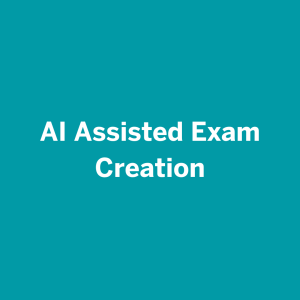8 AI-Assisted Exam Creation (A Genetics Case Study)
|
|
Description of resource(s):
This resource is designed to help instructors effectively use AI tools like ChatGPT for exam writing by providing practical strategies for question generation, revision, and alignment with learning objectives. It highlights AI’s strengths, such as concept-based tasks, while offering guidance on overcoming limitations like logic inconsistencies and handling visual problems.
Links to Resources:
Why I implemented this:
As a Genetics instructor, I’ve always found exam writing to be both a rewarding and time-consuming process. My goal for this resource was to explore whether AI tools like ChatGPT and CoPilot could genuinely support educators in creating high-quality short-answer exam questions. I wanted to share a realistic perspective—not just on AI’s potential but also its limitations—based on my own experiences.
To create this guide, I focused on the key challenges I face as an educator: generating a variety of meaningful questions, aligning them with course objectives, and ensuring they challenge students at appropriate cognitive levels. I began by experimenting with AI tools, comparing their strengths and weaknesses in tasks like revising questions, handling logical problems, and integrating Bloom’s Taxonomy and my learning objective “tags.” Through trial and error, I developed strategies to maximize the effectiveness of AI assistance, such as giving precise prompts and reviewing AI outputs critically.
This resource distills those lessons into practical advice. It’s written for instructors like me, who seek to balance the efficiencies of technology with the thoughtful, nuanced work of teaching complex subjects. My hope is that it provides you with actionable insights to enhance your own exam-writing process!
My main takeaways:
The main takeaways from this project are that AI tools like ChatGPT can effectively assist in writing and revising exam questions when used with clear, detailed prompts. They excel at concept-based tasks and aligning questions with learning objectives but struggle with logic-based or visual problems. To maximize their utility, instructors should use AI as a supportive tool, not a replacement, and always review outputs for accuracy, ensuring exams maintain rigor and relevance to teaching goals.
What else should I consider?
Timing: Implementing this resource requires an initial investment of time to familiarize yourself with AI tools like ChatGPT and refine your prompt-writing skills. Depending on your experience with AI, preparing a set of AI-assisted exam questions may take 2–4 hours initially, reducing with practice. Once proficient, integrating AI into your exam-writing workflow can significantly shorten preparation time.
Context: This resource is ideal for college-level courses or other science classes where short-answer questions assess conceptual understanding and problem-solving. It is especially useful in courses with established learning objectives, as AI can help align questions to specific cognitive levels and instructional goals.
Adaptations: This resource can be adapted for various contexts:
- Intro-Level Courses: Focus on basic concept-driven questions with simpler prompts.
- Higher-Level Courses: Use AI to refine questions requiring deeper analysis, like multi-step genetic problems.
- Larger Classes: Leverage AI to generate multiple versions of questions for large-scale assessments.
- Group or Individual Settings: Incorporate AI-generated scenarios into collaborative problem-solving exercises or individual practice quizzes.
Potential Pitfalls: Instructors might over-rely on AI outputs without thorough review, resulting in errors in logic, inconsistencies, or mismatched learning objectives. Additionally, AI-generated questions may lack the nuance or creativity needed for deeper engagement. To mitigate this, always verify accuracy, test questions with peers or TAs, and adjust prompts as needed for clarity and specificity.




